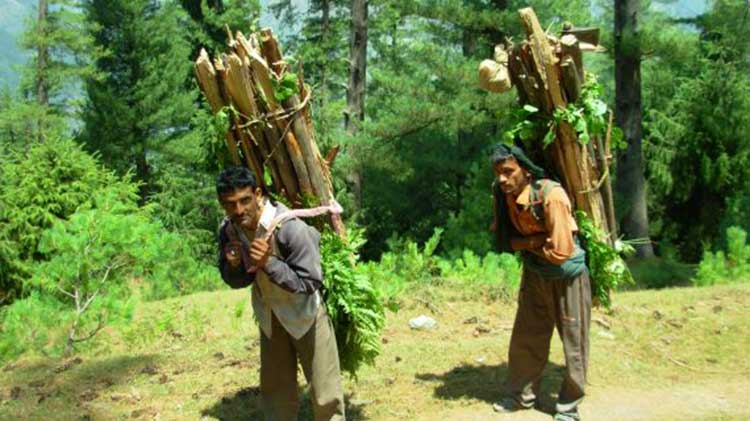
The new paper ‘A Framework for Reforming India’s Forest Biodiversity Management Regime’ by Dr S. Faizi and Dr M. Ravichandran published in the UN journal Natural Resources Forum in its August 2016 issue provides a rare insight into India’s forest management and outlines a trajectory for reforming the forest management departing from the colonial approach and taking on board the historically neglected concerns of the forest dependent communities. Forest management is addressed from the perspective of the CBD objectives and India’s Constitutional principles. Faizi who has been one of the long time negotiators in the CBD (Convention on Biological Diversity) parlance is an eminent ecologist. Here I am providing some highlights of the paper which is already being discussed widely.
The three objectives of the CBD are conservation, sustainable use and benefit sharing.
The authors underline the paramount importance of the Forest Rights Act in addressing the challenge to conserve ‘the 96,373 known species of fauna and 56,515 known species of flora (including fungi and lichens) and eradicate poverty among the Adivasis and other forest-dependent communities’
‘The Scheduled Tribes and Other Traditional Forest Dwellers Act, 2006 (FRA) has marked a paradigm shift from the exclusionary notion of conservation to recognising community rights over forests, and empowering local communities to protect and manage forest biodiversity.
The FRA (2006) best translates the key CBD provisions and its ecosystem approach into domestic legislation, and is as much about managing forest biodiversity at the local level as about undoing the ‘historical injustice’ committed to the indigenous people. The law seeks to “strengthen the conservation regime of the forests while ensuring the livelihood and food security” of these communities. It provides for the sustainable harvesting of forest produce by local communities, in addition to the recognition of historical rights over forests, extinguished by the British colonial regime through the Indian Forest Act (1927), a legacy carried on by the post-independence government. Equally important is that in Section V of the act, it empowers the local communities to protect and manage forest biodiversity and associated ecosystems. This ground-breaking legislation devolves the power for biodiversity management to the local communities, and the rules issued under the act provide for the creation of the necessary local level institutions for forest management, as well as require the government to provide capacity-building support to such institutions…..’
But, though the FRA is a ground-breaking legislation,
‘the inherent resistance within the forest departments to share power with the communities remains a challenge to the effective enforcement of (its) provisions.’
The trouble is the multiplicity of legislation pertaining to forests and biodiversity, and the fact that they ‘retain the colonial legacy of exclusionary conservation.’ Therefore the paper calls for the creation of ‘a single national legislation that covers multiple issues related to biodiversity management and community rights. Such a reform of the legal regime is also necessary to harmonize the national legislation with the CBD.’
The Ministry of Environment and Forests has recommended to the States that the Joint Forest Management committees should be made organs of the Gram Sabha under Panchayati Raj (local self-government) institutions (PRIs). However that has not happened yet.
The authors make an extremely important point that needs to be understood by lay people.
‘Biodiversity management cannot be limited to legally protected areas, but should cover the contiguous landscapes as well, in order for management efforts to be successful. The landscape-wide management of resources enables the effective application of the ecosystem approach and the influence of land-use patterns beyond the formally protected areas. This also provides an opportunity for the often fragmented management agencies to work together towards a common goal in a given landscape and seek synergies.’
The paper criticises the Indian Biological Diversity Act, which, it says,
‘has the limited operational mandate of regulating access to biodiversity, failing to translate the triple objectives of the CBD and the principles of the ecosystem approach into domestic law.’
The authors do not beat around the bush on the shortcomings of the present forest management regime. They say:
‘The Indian Forest Act is a legacy of the colonial regime, while the Wildlife (Protection) Act (WLPA) has in it provisions that impede the emerging paradigm of devolution and community participation in biodiversity management.’
‘Section 36.C of the WLPA states that community reserves can be declared in community lands or private lands where the community or individual has volunteered to do so, but outside existing protected areas.’ But ‘only four community reserves out of a total 668 protected areas have been established in the country so far.’
The authors, however, also caution against common national guidelinesfor the Community Reserves as they
‘cannot address the diverse socio- economic contexts that exist in potential community reserve sites across the country.’ ‘The thousands of natural sites that are managed based on social sanctions and customary rules by local communities are important repositories of biodiversity. These sites have differing management systems since they have differing ontogenies, but the underlying principles are conservation and sustainable use. The sites vary from village ponds to forest catchment areas or vestiges of previously dense forests. These sites reflect the historical practice of sustainable resource use, and vary considerably according to the size of the area. Many community-managed areas also have complex social dynamics, in which the communities often have to face different types of pressure, increasingly commercial.’ ‘Such sites are recognized by the CBD’s Programme of Work on Protected Areas, and by the World Parks Congress. Since the socio-economic ground on which these self-governed sites stand is changing and the pressures of competing land-use options are likely to increase, efforts to promote the sustainability of such sites should be made. However, such promotion should be done without altering the autonomous nature of these biodiversity management enterprises….’
The displacement of Adivasis from their forest homes is a national calamity, and it is especially tragic when it is done from reserved forests. The authors say that
‘a good part of the total estimate of 2.6 million Adivasis displaced from their forest homes includes reserved forest-related displacements.’
‘The avoidable crisis of the displacement of the forest-dependent poor can be effectively addressed within existing laws and policies, albeit with a shift in the approach in implementation, or by regarding the protected areas system as an inclusive conservation enterprise, in which the people who have been the traditional custodians of the forests and wildlife should be recognised as partners in conservation and their livelihood concerns respected, as envisaged in the CBD Programme of Work on Protected Areas. The FRA, which vests the forest communities with the right to protect the forests, strengthens this approach and provides the legal tools to operationalize the same, as well as sets categorical terms for the resettlement of people, whether for conservation or development purposes. This shift in approach within the conservation sector has already begun.’
In summary then, the FRA
‘can be used to effectively address the twin crisis of poverty and biodiversity degradation in the forest areas. It is imperative to harness the law’s strength to turn the local communities into effective resource managers and to build partnerships with them in the conservation enterprise. The government agencies working in the forest landscapes, especially the forest departments, tribal departments and the Panchayati Raj institutions should shed their fragmented approaches and develop meaningful coordination among themselves, providing much needed capacity-building support to the Gram Sabhas, in order to enable them to effectively discharge the statutory forest management responsibilities vested with them. That is particularly important considering the fact that up to 71.7% of the country’s dense forest cover is found in the 188 tribal districts.’
If government were serious about support to Adivasis they would also look into the intractable problem of Human Wildlife Conflict (HWC).
‘Habitat improvement of wildlife areas and the prevention of habitat fragmentation provide a long-term solution to the problem in relation to most species. Apart from addressing the basic issues arising from habitat fragmentation, village-level mechanisms led by Panchayat institutions should be set up and supported for addressing this vexing issue.’
The paper calls for a convergence of the multiple departments related to forests, biodiversity and the forest dependent people.
‘A statutory convergence of the current forest departments, tribal welfare departments and Panchayat Raj institutions is also essential in creating a biodiversity governance system that would address both conservation and livelihood concerns, and convert communities to partners in conservation rather than render them victims. Policy reform followed by regal reform will ease biodiversity management, reconciling conservation needs and community interests, and create new institutional arrangements at various levels.‘
The authors surmise on the large staff of 115000 in the forest departments,
‘in fact, when there is greater devolution of biodiversity management to local community institutions, the size of forest staff can be progressively reduced.’
Another crime being perpetrated in forests is biopiracy. Benefit sharing (ABS) means a system for sharing the benefits of sale of commercial products from forests.
‘The MoEF has pointed out that over 2,000 patents based on Indian biodiversity and traditional knowledge were taken out in Western patent offices every year. There are practical difficulties and resource limitations to oppose every such illegal patent in Western patent offices. The issue can be effectively addressed in a three-pronged way. Patents taken out abroad without following the binding ABS provisions of the CBD constitute infractions of the convention, …and the civil court of a party (country) must recognise the infraction. Second, …national and state biodiversity boards (should) track and create an inventory of cases of infractions of the CBD and the BDA, and ..pursue legal measures. Third, the cases of infractions of the CBD should be brought to the attention of the Conference of Parties (CoP), since the CoP is mandated to review the progress of the implementation of the convention. The CoP may also be encouraged to address the non-compliance of Article 15.7 of the convention, which commits parties to take legislative, administrative or policy measures to enforce ABS provisions of the convention.’
The authors finally point out,
‘…. the economic valuation of biodiversity and ecosystem functions provides insights into the scale of contribution of natural capital to the rural economy and helps, for example, to design compensatory measures for forest-dependent communities in proportion to the value of the ecological resource base that they are often asked to forego for the sake of long-term conservation, discarding the current approach of nominal compensation.’
‘Protected areas constitute 4.9% of the geographical area of the country, and together with reserve forests and protected forests means that close to a quarter of the area of the country is legally protected for bio-resource management. …. The landscape approach will, irrespective of the ecosystem type where it is applied, pursue an integrated and comprehensive method of management covering the entire matrix of land-use forms, including protected areas, in a given landscape. The landscape approach will address conservation, sustainable use and production as well as other land-use needs, involve the local populace in planning and management exercises, and be governed by the existing laws, albeit with the necessary institutional reform. Protected areas will be a pivotal component here, and the management of the rest of the land-use mosaic will be re-oriented to be biodiversity-compatible, and also protect the integrity of ecological processes by incorporating these objectives in the larger development agenda of the area through management strategies and plans. This would provide the much- needed biodiversity corridors and buffer zones and protect ecological processes that operate on a larger space, without entailing extra costs to local communities. The landscape approach would in fact be a re-invention of the old practice of sustainable natural resource use that was in vogue long before the arrival of the Western-inspired protected area system that regarded these sites as isolated islands of conservation.’
It is to be fervently hoped that strong and active support for the proposals from all the stakeholders will make these urgently needed reforms to India’s forest management regime a reality in the very near future.
Anandi Sharan is a historian and blogger based in Bangalore. She was at one time running an NGO funded by the United Nations Framework Convention on Climate Change Clean Development Mechanism to pay for biogas plants and improved cookstoves in Kolar District and some Photovoltaic Lights in Tumkur District. Now she is a board member for a two year term of the Convention on Biodiversity Alliance. She also has a consultancy assignment to provide photovoltaic lighting systems for an NGO in Araria District. She can be contacted at [email protected].














































